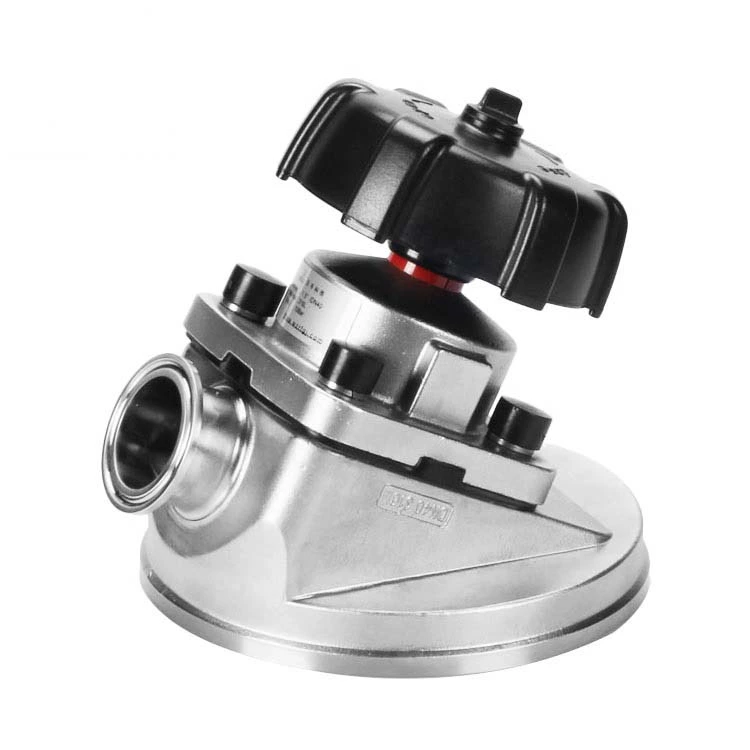Working Principle, Installation, Maintenance And Repair Methods Of Stainless Steel Pneumatic Diaphragm Valve
Sanitary Diaphragm Valve is a stop valve that uses a diaphragm as a start and close member to close the flow channel, cut off the fluid, and separate the inner cavity of the valve body from the inner cavity of the valve cover. The diaphragm is usually made of elastic, corrosion-resistant, and non-permeable materials such as rubber and plastic. The valve body is mostly made of plastic, fiberglass, ceramic or metal-lined rubber materials. It has a simple structure, good sealing and corrosion resistance, and low fluid resistance. It is used for low-pressure, low-temperature, highly corrosive media and media containing suspended substances. According to the structural form, there are ridge type, stop type, gate type, etc. According to the drive mode, there are manual, pneumatic, and electric.
The stainless steel pneumatic diaphragm valve uses a corrosion-resistant lined valve body and a corrosion-resistant diaphragm instead of a valve core assembly, and uses the movement of the diaphragm for regulation. The valve body material of the diaphragm valve is cast iron, cast steel, or cast stainless steel, and is lined with various corrosion-resistant or wear-resistant materials, diaphragm materials rubber and polytetrafluoroethylene. The lined diaphragm has strong corrosion resistance and is suitable for regulating highly corrosive media such as strong acids and alkalis.
The diaphragm valve has a simple structure, small fluid resistance, and a larger flow capacity than other types of valves of the same specification; it has no leakage and can be used to regulate high-viscosity and suspended particle media. The diaphragm isolates the medium from the upper cavity of the valve stem, so there is no filler and the medium will not leak out. However, due to the limitations of the diaphragm and lining materials, the pressure resistance and temperature resistance are poor, and it is generally only suitable for a nominal pressure of 1.6MPa and below 150°C.
The flow characteristics of the diaphragm valve are close to the fast-opening characteristics. It is approximately linear before 60% of the stroke, and the flow rate does not change much after 60%. Pneumatic diaphragm valves can also be equipped with feedback signals, limiters, positioners and other devices to meet the needs of automatic control, program control or flow regulation. The feedback signal of the pneumatic diaphragm valve adopts contactless sensing technology. This product uses a diaphragm propulsion cylinder to replace the piston cylinder, eliminating the disadvantages of the piston ring being easily damaged, causing leakage and causing the inability to push the valve to open and close. When the air source fails, the handwheel can still be operated to open and close the valve.
The sealing principle of the diaphragm valve is to press the diaphragm or diaphragm assembly to fit the channel of the weir-type lined valve body or the straight-through lined valve body by the downward movement of the operating mechanism to achieve sealing. The size of the sealing specific pressure is achieved by the downward pressure of the closing member. Since the valve body can be lined with various soft materials, such as rubber or polytetrafluoroethylene, and the diaphragm is also made of soft materials, such as polytetrafluoroethylene lined with rubber or synthetic rubber, a small sealing force can achieve a perfect seal.
The stainless steel pneumatic diaphragm valve is a special form of shut-off valve. Its opening and closing parts are a diaphragm made of soft materials, which separates the inner cavity of the valve body from the inner cavity of the valve cover. Due to the limitations of the valve body lining process and the diaphragm manufacturing process, the manufacturing process of larger valve body linings and larger diaphragms is difficult, so the diaphragm valve is not suitable for larger pipe diameters and is generally used in pipelines below DN200.
Due to the limitations of the diaphragm material, the diaphragm valve is suitable for low pressure and low temperature occasions. Generally, it should not exceed 180℃. Since diaphragm valves have good anti-corrosion properties, they are generally used in devices and pipelines with corrosive media. The operating temperature and applicable media of diaphragm valves are limited by the lining material of the diaphragm valve body and the diaphragm material.
